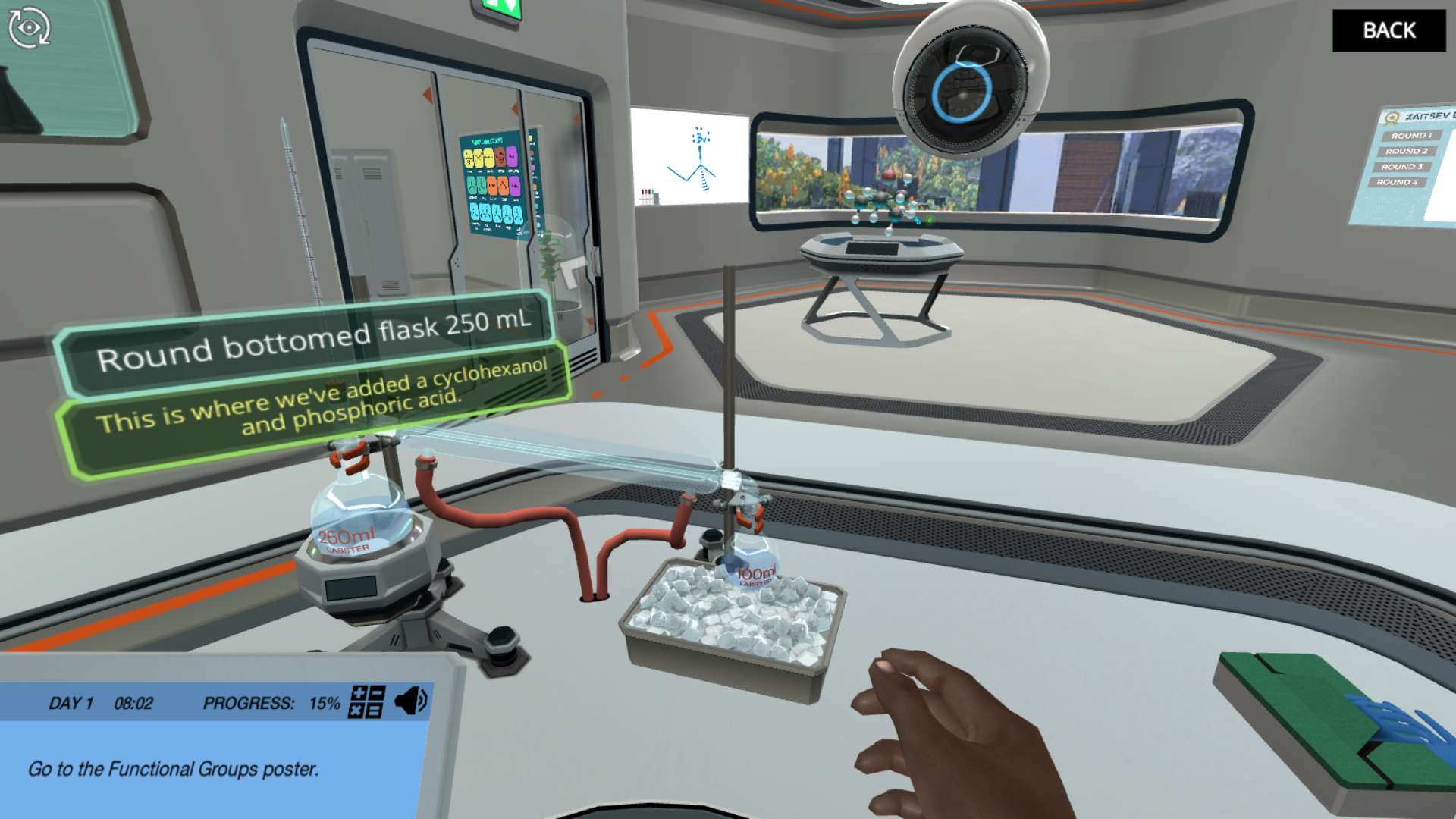Heading 1
Heading 2
Heading 3
Heading 4
Heading 5
Heading 6
Lorem ipsum dolor sit amet, consectetur adipiscing elit, sed do eiusmod tempor incididunt ut labore et dolore magna aliqua. Ut enim ad minim veniam, quis nostrud exercitation ullamco laboris nisi ut aliquip ex ea commodo consequat. Duis aute irure dolor in reprehenderit in voluptate velit esse cillum dolore eu fugiat nulla pariatur.
Block quote
Ordered list
- Item 1
- Item 2
- Item 3
Unordered list
- Item A
- Item B
- Item C
Bold text
Emphasis
Superscript
Subscript
About This Simulation
Join Kim in the Polymer Research Lab to solve the puzzle of unexpected side product formation in their optimized cyclohexanol elimination reaction. Use and expand your organic chemistry knowledge to do this and get the polymer production back on track.
Learning Objectives
- Explain the reaction mechanisms of the E1 and E2 reactions
- Compare the reactivity of different alkyl halides towards E1 and E2
- Predict the product of an Elimination Reaction using Zaitsev’s rule
- Predict the double-bond stereochemistry of the product in an E2 reaction
About This Simulation
Lab Techniques
Related Standards
- No direct alignment
- No direct alignment
- No direct alignment
Learn More About This Simulation
Eliminate the leaving group and get double-bonded! In this simulation, you will learn the ins and outs of Elimination Reactions in Organic Chemistry. You will get hands-on experience with some alkyl halides and discover how they go through the E1 and E2 eliminations.
Polymer production going sideways
Meet Kim: a research scientist at a polymer research and production lab. They are having problems with optimizing their elimination reaction that converts cyclohexanol to cyclohexene, and they need your help to understand what’s going on and how to get it right. You will need to understand the core concepts of elimination reactions to be able to help her out!
Eliminating the unknowns
Back in the main lab, you will brush up on your organic chemistry know-how. After understanding Kim's reaction a little better, you will dive into the two main types of elimination reaction: the E1 and E2. You will be able to hands-on manipulate molecules to go through the mechanisms of the two reactions, before being challenged to figure out Zaitsev’s rule through an explorative and interactive exercise. You will also need to assess what reactants are more likely to go through the two reactions. If you get this, you might get the rockstar achievement!
Back on track
To get to the bottom of Kim’s production puzzle, you will have to carefully work out the mechanisms of the two reactions and what determines their reactivity and the products they form. Will you be able to help her solve it, so her research lab can continue producing polymers for the world?
For Science Programs Providing a Learning Advantage
Boost STEM Pass Rates
Boost Learning with Fun
75% of students show high engagement and improved grades with Labster
Discover Simulations That Match Your Syllabus
Easily bolster your learning objectives with relevant, interactive content
Place Students in the Shoes of Real Scientists
Practice a lab procedure or visualize theory through narrative-driven scenarios


FAQs
Find answers to frequently asked questions.
Heading 1
Heading 2
Heading 3
Heading 4
Heading 5
Heading 6
Lorem ipsum dolor sit amet, consectetur adipiscing elit, sed do eiusmod tempor incididunt ut labore et dolore magna aliqua. Ut enim ad minim veniam, quis nostrud exercitation ullamco laboris nisi ut aliquip ex ea commodo consequat. Duis aute irure dolor in reprehenderit in voluptate velit esse cillum dolore eu fugiat nulla pariatur.
Block quote
Ordered list
- Item 1
- Item 2
- Item 3
Unordered list
- Item A
- Item B
- Item C
Bold text
Emphasis
Superscript
Subscript
A Labster virtual lab is an interactive, multimedia assignment that students access right from their computers. Many Labster virtual labs prepare students for success in college by introducing foundational knowledge using multimedia visualizations that make it easier to understand complex concepts. Other Labster virtual labs prepare learners for careers in STEM labs by giving them realistic practice on lab techniques and procedures.
Labster’s virtual lab simulations are created by scientists and designed to maximize engagement and interactivity. Unlike watching a video or reading a textbook, Labster virtual labs are interactive. To make progress, students must think critically and solve a real-world problem. We believe that learning by doing makes STEM stick.
Yes, Labster is compatible with all major LMS (Learning Management Systems) including Blackboard, Canvas, D2L, Moodle, and many others. Students can access Labster like any other assignment. If your institution does not choose an LMS integration, students will log into Labster’s Course Manager once they have an account created. Your institution will decide which is the best access method.
Labster is available for purchase by instructors, faculty, and administrators at education institutions. Purchasing our starter package, Labster Explorer, can be done using a credit card if you are located in the USA, Canada, or Mexico. If you are outside of North America or are choosing a higher plan, please speak with a Labster sales representative. Compare plans.
Labster supports a wide range of STEM courses at the high school, college, and university level across fields in biology, chemistry, physics, and health sciences. You can identify topics for your courses by searching our Content Catalog.















